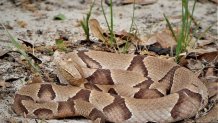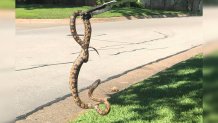The number of venomous snake bites reported in Texas increased last year, especially in suburban areas, according to Texas A&M AgriLife Today.
As temperatures continue to rise in the summer, snakes are more active around the house and in their natural habitats in this part of the year.
Maureen Frank, Ph.D. and Texas A&M AgriLife wildlife specialist, said there’s little to fear about snakes if a few basic precautions and principles are applied before and during an encounter.
The most basic of which is to just leave the snakes alone.
"Most bites occur when a person is trying to handle the snake or trying to kill it," Frank said to AgriLife Today. It’s best to give them plenty of room and let them go on their way. When you encounter a snake, it’s best to just leave it alone."
Snakes are typically not aggressive and will typically escape an area if they hear someone approaching, Frank said.
Last year's summer spike in snake encounters was attributed to rapid urbanization and higher than average amounts of rain.

And before 2020's summer could get fully underway, NBC 5 also reported an uptick in snake encounters in the middle of May. Medical City McKinney reported an increase in snake bite emergency visits in April and May, and local snake removal services said they were busy with snake calls.
Local
The latest news from around North Texas.
Of the roughly 75 snake species in Texas, only about a dozen are venomous.
And those venomous snakes typically don't want to use their venom as a defense and will give warnings before they strike, Frank said.
The Texas Department of Health Services reported that half of all reported bites by venomous snakes were “dry,” meaning no venom was injected into the victim.
Christine Rutter, clinical assistant professor at Texas A&M University, said turning on lights at night, checking the backyard area and/or making noise to announce your presence and giving snakes 20-30 seconds to leave are good starting points to avoiding snake encounters.

Frank recommended removing potential nearby shelter for homeowners.
“It’s best to take the habitat approach and remove the things that attract snakes,” Frank said. “Cutting the grass, removing brush and debris, and trimming the lower branches on bushes and trees will go a long way in reducing the places a snake might want to hide.”
And, Frank said, while many Texans might view snakes as dangerous pests, they're important predators of insects and animals and integral to regional Texas ecosystems.
What To Do With Snake Bites
Wildlife specialist Maureen Frank's first and most important piece of advice when dealing with a venomous snake bite is to stay calm and get to a hospital as soon as possible.
Treatments will differ significantly between how to treat copperhead, cottonmouth or rattlesnake bites, Frank said. So she recommended trying to identify the snake species but not trying to approach it or kill it.
“Do not try to kill it,” she said. “The emergency room doctors don’t need it. They just need a decent description of the snake or take a photo of it with your cell phone if it’s safe to do so. If someone else tries to get the snake, you run the risk that the doctor may be dealing with two snakebite victims.”
Most snake bites will occur to the feet and lower legs or hands. Frank said victims should remove clothing and accessories like socks, bracelets, or jewelry when bitten in the surrounding area to reduce swelling.
Tourniquets and suction devices or using other mythologized methods to remove snake venom could do more harm than good, she said.
“Just focus on getting to the hospital quickly but safely,” she said.



